Insurance
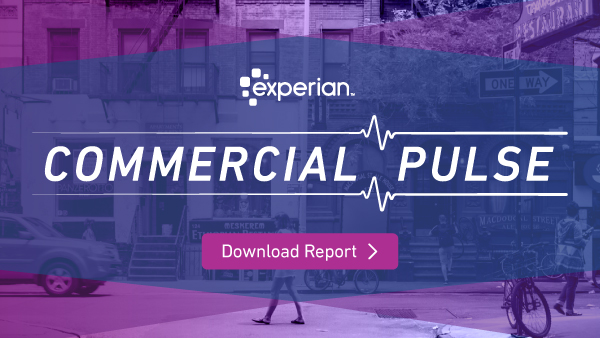
Get the latest Commercial Insights from Experian's October 2024 report—covering inflation, job growth, and why 75% of small businesses remain underinsured.
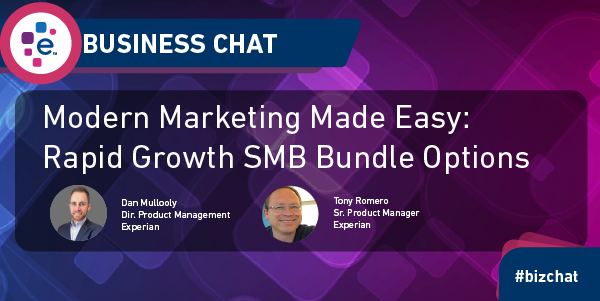
Explore effective marketing strategies for insurance agents and brokers to boost ROI and client engagement.

Join Experian at #ITC2022 to learn to understand the mindset of the industry and learn about where the market is heading.

Employees of a business susceptible to phishing attacks can also impact risk profile of their employer.
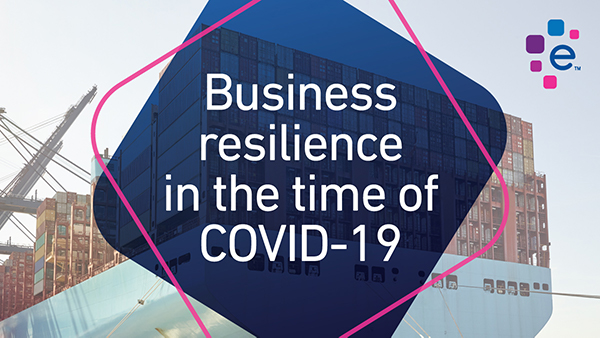
In a favorable economic climate, business resilience is often treated as an afterthought. Success is measured in rapid growth and leaps of progress, while failure is little more than a tempering of that expansion. It’s only when things slow down - like during a global pandemic - that companies are forced to take stock of the ground they stand on. As the economy slows to a crawl and entire industries feel the squeeze, business resilience will determine which organizations make it through to the other side. Whether you’re on the supply side or the demand side, chances are your organization is being tested right now. Here are some practical strategies to stay resilient in the time of Covid-19. Gerard Smith, President of Global Risk Management Solutions (GRMS), works with companies who are either on-boarding new suppliers or evaluating current suppliers. When the Covid-19 pandemic disrupted supply chains in most industries, many of these companies started scrambling to find replacement suppliers. Finding a reliable supplier is always a challenge, but it’s even more difficult during a global pandemic and economic crisis. The best practice here is still to vet new suppliers carefully. Smith’s company creates a risk assessment program for Experian clients that analyzes 50 different financial and legal components, including the following: If they’re on the OFAC sanctions list If they’re financially stable If they actually have the certifications they claim to have If they have insurance If they’ve received negative press Many companies fail to do their due diligence when it comes to suppliers, especially if they’re trying to fulfill orders quickly. More often than not, this leads to bigger problems down the line. If you hire a supplier that’s hemorrhaging money, for instance, they may file for bankruptcy right after you pay them for a major shipment. Companies that use GRMS will be notified regularly if a supplier’s financial or legal status changes. If a supplier cancels their insurance coverage, for example, that could indicate financial struggles. Staying abreast of information like this allows businesses to be proactive with suppliers and avoid being blindsided. Make Sure Clients Are Financially Healthy On the flip side of the buyer-supplier relationship, suppliers are now being asked to extend due dates. Deciding how to comply with these requests can be tricky. Most want to be understanding and reasonable, but there is often legitimate concern over whether they’ll receive payment. Brodie Oldham, Senior Director of Analytic Consultancy for Experian, said Experian offers several services for suppliers who need to gauge how reliable their customers are in this moment. Experian has a special Covid-19 risk index that suppliers can overlay on top of existing credit models. This tool can help determine whether or not a client is in an unstable financial position. If the company operates in a highly impacted part of the country or industry, the supplier can use that information to change the terms. For example, they can sell fewer items to minimize the risk of an unpaid invoice. Experian also monitors credit utilization for business credit cards and other lines of credit. If a company’s credit utilization surpasses a certain threshold, they can alert the supplier who can halt future shipments until the utilization decreases. Find Faster Ways to Evaluate Creditworthiness Many suppliers depend on a company’s credit information to determine its reliability as a buyer. Likewise, credit bureaus are being forced to reevaluate their models in response to the changing business landscape brought on by Covid-19. Enter the agile credit function. The term agile has traditionally been used in the context of software development to describe an iterative approach where requirements and solutions evolve through collaboration between cross-functional teams. It allows companies to adapt to new requests quickly and improve time-to-market. Agile is all about being nimble and responsive - something credit bureaus are prioritizing in today’s uncertain economy. Agile credit means finding new, faster ways of evaluating customers and determining their ability to pay, in a time when that information can change daily. “When everything shut down in March, credit people got thrown for a loop,” said Dan Meder, Vice President of Consulting, Product Marketing and Alliances for Experian Business Information Services. “They needed a way to manage that change very quickly.” That’s where having an agile credit approach comes in. “It’s about using agile principles in your credit function to respond more quickly to changing market needs,” Meder said. Using an agile credit system helps suppliers decide what kind of terms to offer their customers. Many companies are asking suppliers to extend their terms and due dates, often switching from net-30 to net-60. Suppliers then have to decide if they can trust these companies to repay them within that longer time frame, Meder said. If companies in this position use an agile credit function, they can be more responsive and confident in the terms they set out because they’re basing their credit policies on the current state of their customer environment. This requires operating with the latest possible information on how current economic conditions are affecting their customers. Meder said that making credit function more agile requires direction from the head of the credit department and other members of that department. They can also utilize software programmers if the automatic process needs to be updated or any outside consultants for specific analytical expertise. “The idea is to bring together a team of people with direct involvement in managing the credit function to assess how best to manage the customer experience given the current state of the customer environment,” he said. “This includes setting policies around risk assessment as well as credit terms and collection processes.” Meder said companies should have technology that allows them to tinker with their credit function so they can make changes quickly. “This is especially true in a fast-changing or uncertain environment such as what we are seeing with COVID-19 and the uncertain effect it is having on our economy’s future,” he said. “In fact, it is turbulent times such as these where being “agile” is most important since the credit department needs to be able to alter course quickly if the customer environment changes for better or for worse.” Consider Being Flexible With Clients While delayed payments from clients is upsetting, avoid taking your current client relationships for granted. While a more stringent approach from suppliers is understandable right now, Meder cautions companies to remember that the pandemic will end at some point. At that time, companies will remember which suppliers were flexible about payments, due dates and terms - and which companies weren’t. “If you weren’t good to them while they were struggling, they’re going to forget about you when things turn around,” Meder said. To find out how fine-tuning your company’s credit function can help it weather the current economic crisis, reach out to your Experian representative.
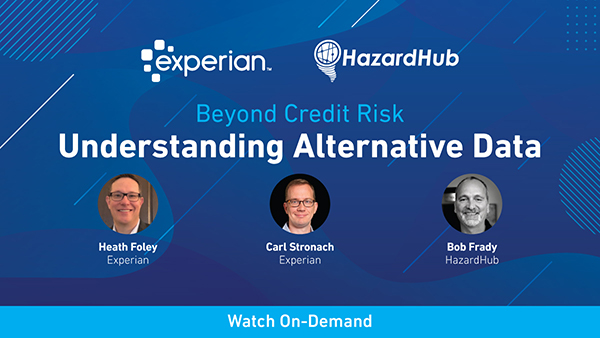
When insurance underwriters make mistakes, bad policies can cost billions. Alternative forms of data is helping change those outcomes, particularly for insurance providers in helping them identify blind spots and accurately underwrite policies. Watch our special Insurance-focused webinar titled "Beyond Credit Risk - Understanding Alternative Data" with HazardHub. Heath Foley and Carl Stronach from Experian is joined by Bob Frady from HazardHub during this lively discussion. Alternative sources of data are growing in importance in the market. The key to our data platform is constantly investing and sourcing a wider variety of data such as geographic hazards, social media, and OSHA data in order to represent a fuller picture of the health of the business. In this one hour talk, we walk through: Utilizing property-level hazard risk assessments The growing importance of alternative sources of data How to bring superior data to power comprehensive insights Related information What is alternative and non-traditional data/

Serving commercial Property & Casualty insurers is a major objective of 3rd parties in the analytics and data space. This industry vertical is one in which standard credit tools already apply to the carrier’s challenge in managing claims risk; there is continued investment within and beyond the industry in developing innovative tools for this purpose. However, a smooth roll out of such tools at scale requires a comprehensive understanding of the regulatory process and its constraints. US Insurance industry- overall regulatory structure: Currently, US carriers are regulated primarily by the individual states, a result of the 1945 McCarran Ferguson Act (“MFA”). Less known is that the MFA was presaged by the Paul v Virginia decision (1869, later overturned by SCOTUS) that held that issuing an insurance policy was not a commercial transaction! [1]. Federal regulatory guidance, ultimately from the Office of the Controller of the Currency (OCC) and the Federal Reserve Board (FRB), is implemented via the National Association of Insurance Commissioners (“NAIC”; see below). NAIC organizes the insurance commissioners from all 50 states, Washington DC, and territories. NAIC maintains legislative databases, market conduct standards, industry financial reporting, conducts training, and many other functions. NAIC provides supervisory guidance for the use of models used to predict insurance loss risk. Among other functions, NAIC has created the Own Risk and Solvency Assessment (“ORSA”) framework which implements existing OCC and FRB guidance to the states. Capital reserves needed for solvency as well as business conduct -- including product definition and general business operations, licensing, maintaining a guaranty fund, underwriting, and rate setting-- are determined primarily by the states in which the carrier operates [2]. Today’s system of state-by-state regulation is more challenging than an equivalent centralized regulating body; insurance carriers operate increasingly online, driving the need for multi-state operations which in turn require multistate licensing and complex regulatory compliance. The average property liability firm has 16 state licenses, while the average life insurance carrier has 25. The coordination of state insurance laws, as well as many other quasi-governmental insurance industry functions, falls under the aegis of the NAIC. We will focus our discussion here on the regulation of risk models. How should third parties align the model building with regulatory requirements? Example 1: Basic filing and disclosure protocol: Responsibility to disclose to state regulators typically lies with the developer or the owner of the model. Disclosure responsibility for custom risk models built around the data of a specific client insurer resides with the insurer, while industry standard models used for multiple clients are typically disclosed by the model developer. Reporting and disclosure requirements vary by state. While the most central functions of interest by state regulators are underwriting and rate setting, any other use of models by insurers may be subject to regulatory disclosure. Models used to assess loss risk for rate setting or underwriting purposes are typically examined for discriminatory impact and use of prohibited data in addition to adequate risk performance and numerical stability. “Prohibited data” varies by state but may include certain data elements gleaned from in-state residents, federal crime data, certain credit data elements, traffic violations exceeding a specified age on the books, or other data; the section below deals with credit data. Finally, the requirement to disclose model details such as attributes and weightings also vary between states, and may require the developer to invoke trade secret status for the subject models to avoid disclosure to the public (implicit in many states). The adjudication of such claims is variable between states, as are all communications with regulators on this topic. Example 2: Use of consumer credit information to underwrite personal insurance policies: Using credit information in models to predict loss risk on personal insurance contracts also has a rich and extremely active history in the US. P&C insurers have generally found that credit risk and claims risk are positively correlated. They have used credit data on individual consumers to various degrees. Notably, the Consumer- Based Insurance Score (CBIS) employs consumer credit parameters and has been used across the insurance industry since 1993. Amid vigorous debate, states have seen active legislative attempts to restrict and define allowable use of consumer credit data by insurers. Credit information in some cases can outweigh a consumer’s driving record in setting rates- leading to the bitter but factual observation that excellent consumer credit can literally outweigh a DUI conviction in some states and conditions. In 2016 alone, the state legislative actions below were considered and/or enacted; note once again that the ability of individual states to regulate independently greatly complicates the picture for large carriers operating in multiple states: California, Hawaii, and Massachusetts do not appear in the table above. In those states, consumer credit information cannot be used to underwrite personal auto policies. Example 3: Reporting channel: State regulators typically require use of the System for Electronic Rate and Form Filing (“SERFF”) database maintained by NAIC for formal submissions: https://login.serff.com/serff/ What’s coming down the road? We have seen examples of the dependence of applicable insurance regulations on individual state laws; the mechanics of model development requires understanding and working with these restrictions. Basic filing and disclosure, permissible model variables, the proprietary status of model detail, and the use of certain consumer information (e.g., credit scores, driving records) are all aspects of risk models whose successful execution depends on understanding the widely variable set of existing state regulations. Several authors have cited the need for a shift in the underlying regulatory structure of the industry from state-based to a national system, citing the inefficiency of the licensing process and the true interstate nature of today’s distribution system. A centralized federal insurance regulatory body would simplify interstate compliance by carriers, but would also introduce other complications. However, it appears prudent in the near-term for 3rd parties developing models to gain awareness of, and streamline, current requirements for regulatory compliance at the state level. Conclusion: There is a considerable additional value that the next generation of models will contribute to the commercial P&C vertical. Insurers and 3rd party developers have demonstrated the applicability of their models and data reports, offering competitive added value with standard risk scores adapted from the credit domain. However, promoting these products more broadly and expanding the product offerings themselves into cyber risk, commercial linkages, and various other tools for insurers, the insurance industry faces efficiency hurdles from our 50-state regulatory framework. With any regulatory centralization unlikely near term, 3rd parties thus need to gain working fluency in NAIC and in the SERFF database, anticipate state-level documentation and disclosure requirements, and attain a level of familiarity with state regulatory machines that enables the management of the interests of their clients with confidence. How Experian can help you Experian provides analytical services for Property & Casualty as well as other insurance product verticals. To enable you to assess claims risk at the time of policy application (or renewal), we either apply standard risk models or develop custom risk models to your underwriting and rate-setting processes. To help you guard against cyber fraud, false identity, and reputation risk, we offer specialty products as well. We also offer special purpose, custom analyses on request, and we sell curated commercial data to your standards as well. References: [1] Brookings Institute. paper on future of regulation- Grace & Klein [2] Insurance Information Institute: Regulation [3] Grant Thornton: ORSA requirements: Model Risk Management for Insurance Companies [4] Blueprint for a Modernized Financial Regulatory Structure, Dept. of Treas., 2008
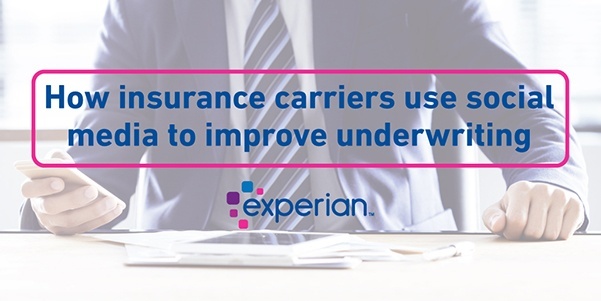
A gastropub restaurant applies for business insurance and is approved. However, social media insights show the restaurant is declining. Even though underwriters usually take a quick look at social media postings, evaluating the trends of the business is not part of the decision process. Costly mistakes: Underwriting using only business supplied information How could something as basic as a business in decline be overlooked in the insurance underwriting process? Think about the process when reviewing a new business insurance application. The underwriter reviews the application and looks at traditional credit and public filing information. Although the underwriter checks out the company website, he doesn’t meet or interact with the company. He then must make a potentially costly business decision about its risk level. Even though the process appears thorough, it does not use the new wealth of information available. How social media provides information about business health If the insurance company had used unique and new sources of social media data, the underwriter would have seen a different picture of the restaurant. The trends in the number of reviews point to a declining business due to poor service, bland food, or increased competition. Traditional data sources miss these subtle signs that point to a higher risk of going out of business. While one poor review shouldn’t result in a denial, a pattern of a declining business is important. This can be spotted using tools that analyze the trends in reviews and ratings for the business line. After all you cannot compare restaurants, with high volumes of social media postings, with say a dry cleaner. By correctly using social media data during the underwriting process, insurers can give an additional lift on the model to determine the risk. Social media data can also help determine more information about the business. For example, an exercise gym may have treadmills and weight machines, or it might actually be a kickboxing studio, which has a much higher level of risk and premiums. Underwriters also get a much more granular view than a typical application, such as the parking situation and the hours. Because risk is higher for businesses with a liquor license, insurers can often learn if a bar didn’t disclose this on their application. Customer photos also often tell a story not detectable on the application, such as broken stairs or a fireplace without proper screens. Using artificial intelligence to analyze social media data Looking through social media for each application takes large amounts of time. Even more importantly, humans may be subject to bias and miss word patterns in reviews. By using an artificial intelligence tool with machine learning capability to analyze social media data for business insurance applications, underwriters can gain a much more accurate picture of the risk they are assuming by insuring a business. Additionally, an AI tool can analyze business health much more quickly than an underwriter could doing the social media check manually. Insurance companies that use artificial intelligence tools to analyze social media data during the underwriting process can more accurately predict the risk of a business. Because the processing speed, adding this additional step does not slow the process down. By reviewing what other people are saying about the business, your insurance company can decrease risk and save money on claims.
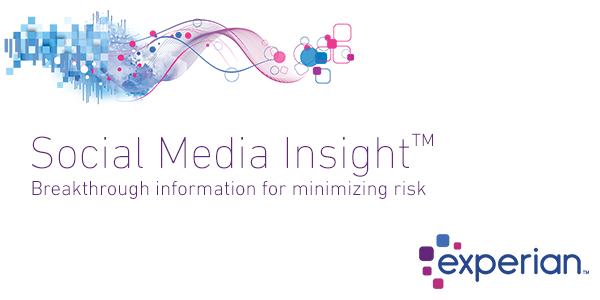
For lenders, alternative data can be the factor in edging out your competitors, especially when better decisions are needed to compete for emerging businesses and startups. Both startups and emerging businesses may represent a good growth opportunity, but they may also be high risk. The challenge? Businesses with thin credit profiles can be difficult to score. Social Media Insight TM provides lenders with another layer of data that can help you better assess the direction of these businesses, score them more accurately and open new growth opportunities. After all, nobody likes to leave money on the table. For emerging businesses who have a thin credit profile but have a strong social media reputation, Social Media Insight can be a factor in gaining access to credit and resources they deserve. Social Media Insight enables you to see the activity, trends and sentiment on a business, over time. In our Experian DataLab tests, we improved overall model performance by 12 percent and new and emerging businesses by 91 percent, boosting predictive performance over traditional data sets. Social Media Insight is directly sourced data providing you with over 70 attributes including trends and sentiment along with descriptive attributes. This powerful data enables you to more accurately score or assess new and emerging business as well as long established accounts. Want to learn more? Watch our on-demand webinar or contact your Experian representative today.
